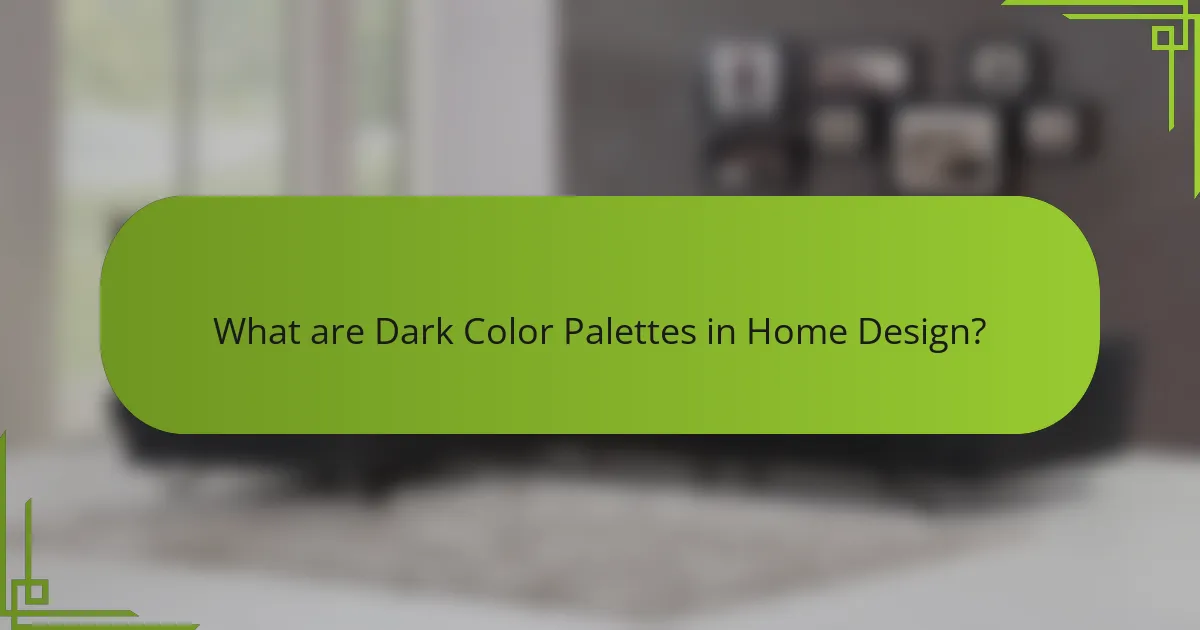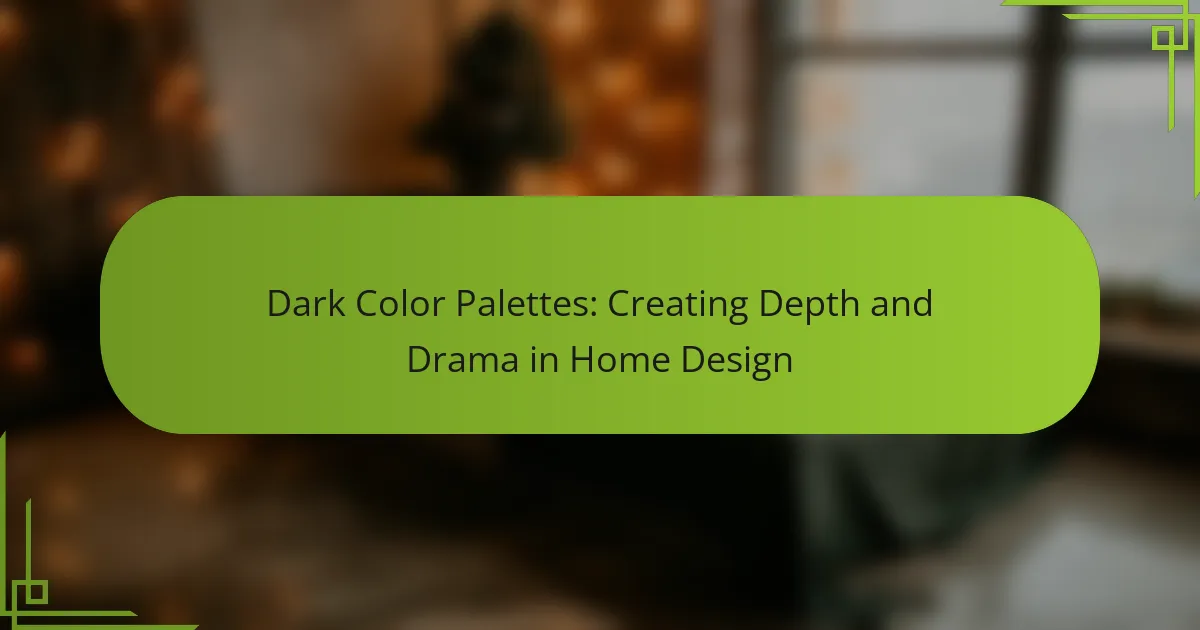
What are Dark Color Palettes in Home Design?
Dark color palettes in home design consist of deep, rich hues that create a dramatic and sophisticated atmosphere. These palettes often include colors like navy blue, charcoal gray, and deep forest green. They are used to add depth to a space and can make rooms feel cozier. Dark colors can also highlight architectural features and furnishings. According to a study by the American Society of Interior Designers, dark colors can enhance a sense of intimacy in larger spaces. Additionally, using dark colors can help in reducing glare from natural light. Overall, dark color palettes are a strategic choice for creating a bold and elegant design aesthetic.
How do Dark Color Palettes influence the overall aesthetic of a space?
Dark color palettes significantly influence the overall aesthetic of a space by creating a sense of depth and drama. These colors can evoke feelings of sophistication and intimacy. Dark hues tend to absorb light, making a room feel cozier and more enclosed. They can also enhance the visual weight of furniture and decor, adding to the overall design impact. For instance, studies show that darker colors can make large spaces feel more inviting. Additionally, dark palettes can serve as a striking backdrop for lighter accents, enhancing contrast and visual interest. This interplay of light and dark can elevate a space’s aesthetic appeal.
What psychological effects do dark colors have on individuals?
Dark colors can evoke various psychological effects on individuals. They often create feelings of sophistication and elegance. Dark colors can also induce a sense of calm and introspection. However, they may be perceived as oppressive or overwhelming in certain contexts. Research indicates that black can symbolize power and authority. Conversely, deep blues and greens are associated with tranquility and stability. The perception of dark colors can vary based on cultural and personal associations. For example, in Western cultures, black is often linked to mourning, while in other cultures, it may represent strength.
In what ways do dark colors enhance or detract from room dimensions?
Dark colors can make a room feel smaller or cozier, while also adding depth. When dark colors are used on walls, they absorb light, creating an intimate atmosphere. This can enhance the perception of room dimensions by making the space feel more enclosed. Conversely, dark colors can also detract from room dimensions by visually shrinking the space. Lighter colors reflect light, creating an illusion of openness, while dark colors do the opposite. Studies in interior design show that dark hues can create a sense of drama and sophistication. However, excessive use of dark colors may overwhelm a small room, making it feel cramped. Balancing dark colors with lighter elements can mitigate this effect.
Why are Dark Color Palettes becoming popular in modern home design?
Dark color palettes are becoming popular in modern home design due to their ability to create depth and drama. These colors provide a bold aesthetic that enhances the overall ambiance of a space. Dark shades can make rooms feel more intimate and cozy, appealing to homeowners seeking comfort. Additionally, they serve as a striking backdrop for lighter furnishings and decor. The trend reflects a shift towards more personalized and expressive interior styles. According to a 2021 report by the National Kitchen and Bath Association, 60% of designers noted an increase in client requests for darker hues. This popularity is also driven by the rise of minimalism, where dark colors can simplify and ground a design.
What trends are driving the use of darker hues in interior spaces?
The trend driving the use of darker hues in interior spaces is a desire for boldness and depth. Homeowners increasingly seek to create dramatic and cozy environments. Darker colors can make spaces feel more intimate and inviting. This shift is influenced by a growing appreciation for moody aesthetics. Designers often utilize darker hues to highlight architectural features. Additionally, these colors can enhance the perception of space by creating contrast. The rise of minimalism has also contributed to this trend. As a result, darker palettes are becoming more popular in contemporary design.
How do cultural influences shape the perception of dark colors in home design?
Cultural influences significantly shape the perception of dark colors in home design. In many Western cultures, dark colors are often associated with sophistication and elegance. For instance, black is frequently used in luxury branding and high-end interior design. Conversely, in some Eastern cultures, dark colors may be linked to mourning or negativity. This cultural context affects homeowners’ choices and preferences. For example, in Japan, dark hues like deep indigo can symbolize calm and stability. Additionally, cultural traditions and historical contexts play a role in color perception. The use of dark colors in Mediterranean design often reflects the region’s historical architecture and climate. Overall, cultural backgrounds influence how dark colors are interpreted and utilized in home design.

What are the Key Benefits of Using Dark Color Palettes?
Dark color palettes enhance depth and drama in home design. They create a sense of sophistication and elegance. Dark shades can make spaces feel cozier and more intimate. They also provide a striking contrast for lighter elements. This contrast can highlight architectural features and decor. Studies show that dark colors can absorb light, reducing glare. This can create a more comfortable visual experience. Additionally, dark colors often evoke a modern aesthetic. They are popular in contemporary design trends.
How do Dark Color Palettes create a sense of depth in a room?
Dark color palettes create a sense of depth in a room by absorbing light and enhancing contrast. This absorption makes walls appear to recede, giving a more expansive feel. Dark colors also highlight architectural features, drawing attention to textures and shapes. The use of shadows in darker shades adds dimension to surfaces. Additionally, dark hues can create a cozy and intimate atmosphere, inviting relaxation. Studies show that darker colors can influence perception of space, making it feel more layered. Overall, dark palettes effectively manipulate visual perception, adding complexity to interior design.
What techniques can be used to maximize depth with dark colors?
To maximize depth with dark colors, use layering techniques. Layering involves combining different shades and textures of dark colors. This creates visual interest and dimension in a space. Incorporate contrasting lighter elements to enhance depth perception. Use lighting strategically to highlight dark surfaces. Natural and artificial light can create shadows that add depth. Employ glossy finishes to reflect light and create a sense of space. Utilize patterns and shapes in dark colors to break monotony. Consider furniture placement to draw the eye and create pathways. These techniques are effective in creating a dynamic atmosphere with dark color palettes.
How do lighting choices impact the effectiveness of dark color palettes?
Lighting choices significantly influence the effectiveness of dark color palettes. Proper lighting can enhance the richness of dark hues, making them appear more vibrant. Conversely, inadequate lighting can render dark colors dull and uninviting. Warm lighting can create a cozy atmosphere, complementing dark shades effectively. Cool lighting can add a modern touch, highlighting the depth of dark colors. Natural light can also amplify the appeal of dark palettes during the day. Additionally, strategically placed light fixtures can create shadows and contrast, adding dimension. Studies show that lighting can alter color perception, affecting how dark palettes are received in a space.
In what ways do Dark Color Palettes contribute to a dramatic atmosphere?
Dark color palettes create a dramatic atmosphere by enhancing depth and contrast in a space. They absorb light, making rooms feel more intimate and cozy. This absorption can also highlight architectural features and textures. Dark colors evoke strong emotions, often associated with sophistication and elegance. They provide a striking backdrop for lighter elements, creating visual tension. Studies show that darker hues can influence mood, promoting feelings of calmness or introspection. Additionally, they can create a sense of mystery and intrigue within a design. Overall, dark color palettes significantly impact the ambiance of a room, reinforcing a dramatic aesthetic.
What specific design elements can enhance the drama of dark palettes?
Contrasting textures can enhance the drama of dark palettes. Using materials like velvet, leather, and metal creates visual interest. Layering these textures adds depth to the design. Bold lighting fixtures can also amplify the drama. Fixtures with warm tones can create a cozy ambiance against dark colors. Artwork with vibrant colors stands out against dark backgrounds. Mirrors can reflect light and create a sense of space. Incorporating plants adds life and contrast to dark palettes. Each of these elements contributes to a rich, dynamic environment.
How can dark colors be balanced with lighter elements for harmony?
Dark colors can be balanced with lighter elements by using contrast effectively. Incorporate lighter shades in furnishings, accessories, or wall art. This creates visual interest and prevents overwhelming darkness. Use neutral tones to bridge the gap between dark and light colors. Layering textures can also enhance balance, such as combining a dark sofa with light throw pillows. Natural light plays a crucial role in harmonizing dark palettes. Strategically placed mirrors can reflect light and brighten dark spaces. These methods ensure a cohesive and inviting atmosphere in home design.

What are the Best Practices for Implementing Dark Color Palettes?
Best practices for implementing dark color palettes include choosing the right shades, balancing with light elements, and considering texture. Dark shades like navy or charcoal can create a sophisticated atmosphere. Pairing dark colors with light furniture or decor enhances contrast and prevents a space from feeling too enclosed. Incorporating various textures, such as matte and glossy finishes, adds depth to the design. Using adequate lighting is crucial; natural light or strategically placed fixtures can brighten dark spaces. Additionally, accent colors should be used sparingly to maintain a cohesive look. Following these practices ensures that dark palettes are both stylish and functional in home design.
How can one effectively choose shades within a dark color palette?
To effectively choose shades within a dark color palette, consider the contrast and undertones of each shade. Dark colors can vary significantly in hue and warmth. Selecting shades with complementary undertones enhances visual interest. For example, pairing a cool navy with a warm charcoal creates depth. Use color swatches to visualize how shades interact in different lighting. Testing shades on walls helps assess their appearance in various conditions. A balanced palette often includes a mix of light and dark shades for dimension. This approach is supported by design principles that emphasize contrast for depth.
What tools or resources are available for selecting dark colors?
Color selection tools for dark colors include color wheel apps and online palette generators. These resources allow users to visualize dark color combinations. Tools like Adobe Color and Coolors help create harmonious palettes. Paint brand websites often provide color visualizers for their products. Color matching apps can also suggest dark shades based on existing colors. Additionally, design software like Sketch and Photoshop offers advanced color selection features. These tools enhance the design process by facilitating the exploration of dark hues.
How do different finishes affect the perception of dark colors?
Different finishes significantly influence the perception of dark colors. Glossy finishes reflect light, making dark colors appear more vibrant and dynamic. In contrast, matte finishes absorb light, often creating a softer, more subdued look. Satin finishes offer a balance, reflecting some light while maintaining depth. The choice of finish can alter the mood of a space. For instance, a glossy black can feel modern and sleek, while a matte black may impart a cozy, intimate atmosphere. Studies show that surface texture impacts color perception, with glossy surfaces enhancing brightness by up to 20%. Thus, selecting the appropriate finish is crucial in achieving the desired visual effect with dark colors.
What tips can ensure that dark colors are used effectively in home design?
To use dark colors effectively in home design, consider balance and contrast. Pair dark hues with lighter shades to create visual interest. Use ample lighting to prevent spaces from feeling closed in. Incorporate textures to add depth and dimension. Limit the use of dark colors to accent walls or specific areas. This approach prevents overwhelming the space. Consider the room’s purpose; darker colors can evoke coziness in bedrooms. Research shows that well-placed dark colors can enhance mood and aesthetics.
How can one avoid common pitfalls when using dark color palettes?
To avoid common pitfalls when using dark color palettes, ensure adequate lighting in the space. Insufficient light can make dark colors feel oppressive. Use a mix of ambient, task, and accent lighting to create balance. Incorporate lighter accents to provide contrast and visual interest. Select appropriate materials that reflect light, such as glossy finishes. This helps to prevent a dull appearance. Be mindful of color harmony; combine dark shades with complementary or analogous colors. This enhances depth without overwhelming the senses. Finally, consider the room’s purpose; darker colors may not suit spaces meant for relaxation or productivity.
What are some successful case studies of dark color palette applications?
Successful case studies of dark color palette applications include the following examples. The “Black House” in New Zealand utilizes a deep black exterior to blend with its natural surroundings. This design enhances the home’s dramatic appearance while maintaining harmony with the landscape. Another case is the “Dark House” in Norway, which employs dark wood and stone to create a cozy yet modern atmosphere. The use of a dark palette here emphasizes the natural light that enters the space. Additionally, the “M House” in Japan features a dark interior that provides a striking contrast to the outdoor greenery. This approach creates an intimate and inviting environment. Each of these examples demonstrates how dark color palettes can effectively enhance architectural designs and interior spaces.
What practical advice can enhance the use of dark color palettes in home design?
To enhance the use of dark color palettes in home design, incorporate ample lighting. Bright lighting balances the darkness and prevents a cramped feel. Use a mix of ambient, task, and accent lighting for versatility. Mirrors can also amplify light and create the illusion of space. Choose lighter furniture and decor to contrast with dark walls. This adds visual interest and prevents monotony. Textures play a crucial role; mix materials like wood, metal, and fabric for depth. Finally, incorporate greenery to soften the look and bring life into dark spaces.
Dark color palettes in home design consist of deep hues that create a dramatic and sophisticated atmosphere, enhancing depth and intimacy in spaces. This article explores how dark colors influence aesthetics, evoke psychological effects, and affect room dimensions, while also discussing current trends and cultural influences shaping their use. Key benefits include their ability to absorb light, reduce glare, and serve as striking backdrops for lighter elements. Best practices for implementing dark palettes, including lighting choices and texture variations, are also highlighted to ensure effective and harmonious design.
